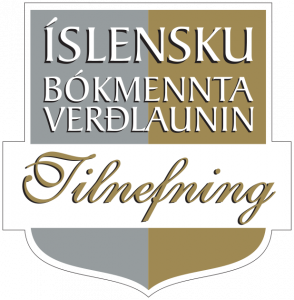6.900kr.

Árið 1771 skrifaði rektor Skálholtsskóla bréf til danskra yfirvalda þar sem hann lagði til að íslenska yrði lögð niður. Íslendingar skyldu taka upp dönsku, tungumál herraþjóðarinnar. Íslenskir mennta- og embættismenn notuðu mest dönsku en alþýðan notaði nær eingöngu íslensku. Rektor vildi meina að íslenskan væri ekki aðeins orðin gagnslaus heldur beinlínis skaðleg ímynd þjóðarinnar.
Hvað gerði það að verkum að framtíð íslenskunnar var tryggð þrátt fyrir ýmsar hindranir? Hér koma við sögu íslenskir málhreinsunarmenn og „baráttumenn“ íslenskunnar en einnig danskir áhugamenn um íslensku — norrænuna fornu — og handritin sem geyma sögu Norðurlanda.
Kristjana Vigdís Ingvadóttir sagnfræðingur fjallar hér um „dönsk áhrif“ á Íslandi á átjándu og nítjándu öld en einnig um mikilvægi íslensku frá siðaskiptum. Hvaða áhrif hafði það á íslenskt samfélag og tungu að vera undir stjórn Dana?
Hér er í fyrsta skipti rannsökuð tungumála-notkun á Íslandi á markvissan hátt með því að rýna í bréfaskipti amtmanna við aðra embættismenn, stjórnvöld og almenning. Þannig fæst skýr mynd af tungumálanotkun Íslendinga á átjándu og nítjándu öld.
En baráttunni fyrir íslenskunni er hvergi nærri lokið. Aðrar ógnir steðja að á tuttugustu og fyrstu öld og þrautseigju þarf enn ef íslenskan á að lifa af.
Formáli
Inngangur
Kveikjan að ritinu, baksvið og fyrri rannsóknir
Uppbygging rits
Fyrsti hluti
Tungumálin og tengslin við samfélagið frá siðaskiptum
1 Aukin tengsl við Danmörku og áhrif þeirra á Íslandi
Breytingar á stjórnskipan Íslands frá sextándu öld
Tungumál stjórnsýslunnar
Dönsk máláhrif innan kirkjunnar og aukin tengsl við dönsk stjórnvöld
Skóla- og fræðslumál: dönskumælandi menntamenn og „elítan“
Verslunarmál og kaupstaðir: Aukin tengsl og samskipti við danska kaupmenn
Danskt samfélag á Íslandi?
2 Mikilvægi íslensku innan danska konungsríkisins
Áhugi á fornritum, fornmáli og upphaf málhreinsunar
Hreintungustefna og móðurmálsvæðing frá átjándu öld
Upplýsingin og aukin útgáfa á íslensku
Lagaboð varðandi íslenskunotkun innan stjórnsýslunnar
Staða Íslands og annarra landa innan danska konungsríkisins
Grænland og grænlenska
Færeyjar og færeyska
Sérstaða Íslands og íslensku: Áhugi fræði- og ferðamanna
Virðing fyrir menningararfi Íslendinga
3 Bréfaskipti embættismanna og almennings á átjándu öld
Amtmenn yfir öllu landinu 1688–1770
Bréfabækurnar
Bréf til amtmanna
Strandasýsla
Dalasýsla
Árnessýsla
„Tvítyngdur“ heimur embættismanna á átjándu öld
Annar hluti
Viðhorf og viðhorfsbreytingar í garð tungumálanna
4 „Lade os antage det danske sprog …“
Hver var Bjarni Jónsson rektor?
Bréf Bjarna til Landsnefndarinnar fyrri 1771
Vildu Íslendingar að danska yrði tekin upp?
Konunghollir föðurlandsvinir Íslands
„Þjóðleysingjar“?
5 Dönskunotkun, dönsk áhrif og gagnrýni á dönsku á nítjándu öld
Tortryggni gagnvart íslenskum embættismönnum
Fjölgun danskra kaupmanna og kaupstaðamenning
Dönskunotkun og „dönsk áhrif“ meðal almennings
Dönskukunnátta mennta- og embættismanna
Gagnrýni á dönskunotkun í stjórnsýslu og áherslan á íslensku
„Bréfaskriftamálið“
Sigur íslenskunnar?
6 Bréfaskipti amtmanna Vesturamts á nítjándu öld
Amtmenn Vesturamts, hlutverk þeirra og skjalasöfn
Hvers vegna Vesturamtið?
Bréfabækur Vesturamts
Bréf til amtmanna Vesturamts
„Hver stafur“ skrifaður á dönsku — eða hvað?
Þriðji hluti
Hugleiðingar um tungumálin
7 Nýjar áskoranir: danska þá og enska nú
Áhrif ensku á íslensku á tuttugustu og fyrstu öld og staða íslensku
Háskólinn og fræðasamfélagið
Stjórnsýslumál í alþjóðasamfélagi
Viðskiptamál og ferðaþjónustan: Welcome to Iceland!
Staða íslensku og umræða um framtíð málsins
Hvers vegna tökum við ekki bara upp ensku?
Lokaorð
Summary
Heimildaskrá
Myndaskrá
Töflur og súlurit
Nöfn og efnisorð
Kristjana Vigdís Ingvadóttir er fædd í Keflavík árið 1993. Hún hefur lokið BA gráðu í sagnfræði með ítölsku sem aukagrein frá Háskóla Íslands. Kristjana hefur starfað hjá Þjóðskjalasafni Íslands frá árinu 2017. Rit þetta byggir á BA ritgerð hennar í sagnfræði og er fyrsta bók höfundar.
Viðtal við höfund í Fréttablaðinu
Viðtal við höfund í Til skjalanna: hlaðvarpi Þjóðskalasafns
Tilnefningar til Íslensku bókmenntaverðlaunanna 2021 í Morgunblaðinu
Tilnefningar til Íslensku bókmenntaverðlaunanna 2021 í Vísi
Viðtal við höfund í Morgunvaktinni á Rás 1
Viðtal við höfund í Víkurfréttum
Viðtal við höfund í Blöndu: hlaðvarpi Sögufélags
Viðtal við höfund í Saga og samfélag á Hringbraut
Perseverance and the importance of the Icelandic language
On the use of Danish and foreign influences on Icelandic
By the eighteenth century, Iceland’s ties with the Danish government and society were stronger than ever before. So great was Denmark’s influence that in the second half of the eighteenth century, there were even thoughts of abandoning the Icelandic language and adopting Danish in its stead; Bjarni Jónsson, the rector at Skálholt (the cultural and political centre of Iceland at the time), was among advocates of such views. This book explores Danish influence on local Icelandic authorities and the use of Danish as an official language. It also examines why, despite this pressure, the Icelandic language survived within local governance.
As Danish influence grew in Iceland, more emphasis was placed on the use of Icelandic. Icelandic was unequivocally the mother tongue of Icelanders, most of whom had little knowledge of Danish. Icelandic intellectuals had been engaged in language purification since the Reformation, and Icelandic was the language used by the church. Various legal requirements by the Danish government regarding the use of Icelandic within local administration, and thus the Danish attitude towards Icelandic, are discussed here. Why were Icelanders permitted to use Icelandic within their local governancewhen Danish was the official language of the Faroe Islands and Greenland? The administrative status of these countries and the use of native languages within the Kingdom of Denmark are further explored; Iceland seems to have been unique insofar as its language was concerned.
Icelandic amtmenn, or district governors, used Danish more than other types of officials, even though they themselves were Icelandic and corresponded in Icelandic with their fellow countrymen. To shed light on the linguistic aspect of these relations, written correspondence by eighteenth- and nineteenth-century officials is examined, including the records of the amtmenn and the letters they received from magistrates but also from the general public and others. In so doing, the evolution of language use within local administration is traced.
Most eighteenth-century Icelandic officials used both languages: while Icelandic was their mother tongue, Danish was their “working language”. In the early nineteenth century, the grammarian and philologist Konráð Gíslason spoke of officials who used Danish as “nationless”, as if such usage prevented allegiance to their homeland. Also explored here are the views of the writer Eggert Ólafsson and chief justice (dómstjóri) Magnús Stephensen on Danish in the eighteenth century as well as their attitude towards the government. Could eighteenth-century intellectuals and officials not be “friends of the fatherland” if they used too much Danish?
In the nineteenth century, officials continued to use Danish in Iceland, and the public continued to criticise such usage. Was Danish more widespread than ever? The “letter writing case”, which demanded that only Icelandic be used as an administrative language both locally and in communication with the Danish government, is addressed. The case was presented to the Althing several times and was probably related to an increased use of Icelandic as the century went on. Also discussed here is the surge of public interest in Danish in the nineteenth century, as well as the Danes’ influence on Icelandic society. This includes various professional associations arising in the second half of the nineteenth century and the education these associations offered, as well as the social influence of merchants.
In the eighteenth and nineteenth centuries, it was mainly Danish that influenced Icelandic, but today anglophone influences are most notable. In a way, Icelandic has the same “problems” now as when Skálholt rector Bjarni Jónsson complained about its shortcomings in 1771. To reflect on how Icelandic has survived, contemporary language use is discussed, as is the question as to why English has not been adopted in Iceland—the answer being the same as to why Danish was not adopted in the eighteenth century. The arrival of the British and later the American forces had various impacts on Iceland, including their linguistic influence. Globalisation and increased international ties also call for more communication in English. Today, the use of English in Iceland and the adoption of English loanwords are criticised, whether in business and tourism or elsewhere. How has the Icelandic language survived for so long despite the challenges and the impacts of other languages on its use among native speakers?

Hægt er að skrá sig í áskrift á öllum tíu bindunum sem væntanleg eru á næstu árum. Áskrifendur fá 30% afslátt á bókunum, kröfu í heimabanka og bækurnar sendar heim strax við útkomu þeirra.